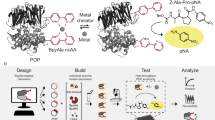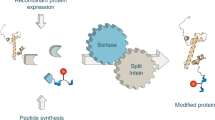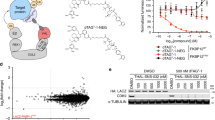Abstract
One of the most important current scientific paradoxes is the economy with which nature uses genes. In all higher animals studied, we have found many fewer genes than we would have previously expected. The functional outputs of the eventual products of genes seem to be far more complex than the more restricted blueprint. In higher organisms, the functions of many proteins are modulated by post-translational modifications (PTMs)1. These alterations of amino-acid side chains lead to higher structural and functional protein diversity and are, therefore, a leading contender for an explanation for this seeming incongruity. Natural protein production methods typically produce PTM mixtures within which function is difficult to dissect or control. Until now it has not been possible to access pure mimics of complex PTMs. Here we report a chemical tagging approach that enables the attachment of multiple modifications to bacterially expressed (bare) protein scaffolds: this approach allows reconstitution of functionally effective mimics of higher organism PTMs. By attaching appropriate modifications at suitable distances in the widely-used LacZ reporter enzyme scaffold, we created protein probes that included sensitive systems for detection of mammalian brain inflammation and disease. Through target synthesis of the desired modification, chemistry provides a structural precision and an ability to retool with a chosen PTM in a manner not available to other approaches. In this way, combining chemical control of PTM with readily available protein scaffolds provides a systematic platform for creating probes of protein–PTM interactions. We therefore anticipate that this ability to build model systems2 will allow some of this gene product complexity to be dissected, with the aim of eventually being able to completely duplicate the patterns of a particular protein’s PTMs from an in vivo assay into an in vitro system.
This is a preview of subscription content, access via your institution
Access options
Subscribe to this journal
Receive 51 print issues and online access
$199.00 per year
only $3.90 per issue
Buy this article
- Purchase on Springer Link
- Instant access to full article PDF
Prices may be subject to local taxes which are calculated during checkout




Similar content being viewed by others
References
Wold, F. In vivo chemical modification of proteins (post-translational modification). Annu. Rev. Biochem. 50, 783–814 (1981)
Davis, B. G. Mimicking posttranslational modifications of proteins. Science 303, 480–482 (2004)
Dwek, R. A. Glycobiology: Toward understanding the function of sugars. Chem. Rev. 96, 683–720 (1996)
Davis, B. G. Synthesis of glycoproteins. Chem. Rev. 102, 579–601 (2002)
Davis, B. G., Lloyd, R. C. & Jones, J. B. Controlled site-selective glycosylation of proteins by a combined site-directed mutagenesis and chemical modification approach. J. Org. Chem. 63, 9614–9615 (1998)
Kiick, K. L., Saxon, E., Tirrell, D. A. & Bertozzi, C. R. Incorporation of azides into recombinant proteins for chemoselective modification by the Staudinger ligation. Proc. Natl Acad. Sci. USA 99, 19–24 (2002)
van Hest, J. C. M., Kiick, K. L. & Tirrell, D. A. Efficient incorporation of unsaturated methionine analogues into proteins in vivo.. J. Am. Chem. Soc. 122, 1282–1288 (2000)
Fodje, M. N. & Al-Karadaghi, S. Occurrence, conformational features and amino acid propensities for the pi-helix. Protein Eng. 15, 353–358 (2002)
Cubellis, M. V., Rozzo, C., Montecucchi, P. & Rossi, M. Gene 94, 89–94 (1990)
Easton, R. L., Patankar, M. S., Clark, G. F., Morris, H. R. & Dell, A. Pregnancy-associated changes in the glycosylation of Tamm-Horsfall glycoprotein. J. Biol. Chem. 275, 21928–21938 (2000)
Campbell, S. J., Carlotti, F., Hall, P. A., Clark, A. J. & Wolf, C. R. Regulation of the CYP1A1 promoter in transgenic mice: An exquisitely sensitive on-off system for cell specific gene regulation. J. Cell Sci. 109, 2619–2625 (1996)
Rostovtsev, V. V., Green, L. G., Fokin, V. V. & Sharpless, K. B. A stepwise Huisgen cycloaddition process: Copper-catalyzed regioselective ligation of azides and terminal alkynes. Angew. Chem. Int. Edn 41, 2596–2599 (2002)
Tornøe, C. W., Christensen, C. & Meldal, M. Peptidotriazoles on solid phase: [1,2,3]-triazoles by regiospecific copper(I)-catalyzed 1,3-dipolar cycloadditions of terminal alkynes to azides. J. Org. Chem. 67, 3057–3064 (2002)
Vosseller, K., Sakabe, K., Wells, L. & Hart, G. W. Diverse regulation of protein function by O-GlcNAc: a nuclear and cytoplasmic carbohydrate post-translational modification. Curr. Opin. Chem. Biol. 6, 851–857 (2002)
Somers, W. S., Tang, J., Shaw, G. D. & Camphausen, R. T. Insights into the molecular basis of leukocyte tethering and rolling revealed by structures of P-and E-selectin bound to SLe(X) and PSGL-1. Cell 103, 467–479 (2000)
Kansas, G. S. Selectins and their ligands: Current concepts and controversies. Blood 88, 3259 (1996)
Leppänen, A., White, S. P., Helin, J., McEver, R. P. & Cummings, R. D. Binding of glycosulfopeptides to P-selectin requires stereospecific contributions of individual tyrosine sulfate and sugar residues. J. Biol. Chem. 275, 39569–39578 (2000)
Nelson, R. M., Dolich, S., Aruffo, A., Cecconi, O. & Bevilacqua, M. P. Higher-affinity oligosaccharide ligands for E-selectin. J. Clin. Investig. 91, 1157–1166 (1993)
Barkalow, F. J., Goodman, M. J., Gerritsen, M. E. & Mayadas, T. N. Brain endothelium lack one of two pathways of P-selectin-mediated neutrophil adhesion. Blood 88, 4585–4593 (1996)
Sibson, N. R. et al. MRI detection of early endothelial activation in brain inflammation. Magn. Reson. Med. 51, 248–252 (2004)
Ferrari, C. C. et al. Reversible demyelination, blood-brain barrier breakdown, and pronounced neutrophil recruitment induced by chronic IL-1 expression in the brain. Am. J. Pathol. 165, 1827–1837 (2004)
Gotsch, U., Jager, U., Dominis, M. & Vestweber, D. Expression of P-selectin on endothelial cells is upregulated by LPS and TNF-alpha in vivo.. Cell Adhes. Commun. 2, 7–14 (1994)
Bernardes-Silva, M., Anthony, D. C., Issekutz, A. C. & Perry, V. H. Recruitment of neutrophils across the blood-brain barrier: The role of E- and P-selectins. J. Cereb. Blood Flow Metab. 21, 1115–1124 (2001)
Schofield, L. & Grau, G. E. Immunological processes in malaria pathogenesis. Nature Rev. Immunol. 5, 722–735 (2005)
Grau, G. E. et al. Platelet accumulation in brain microvessels in fatal pediatric cerebral malaria. J. Infect. Dis. 187, 461–466 (2003)
Sun, G. et al. Inhibition of platelet adherence to brain microvasculature protects against severe Plasmodium berghei malaria. Infect. Immun. 71, 6553–6561 (2003)
Khidekel, N., Ficarro, S. B., Peters, E. C. & Hsieh-Wilson, L. C. Exploring the O-GlcNAc proteome: Direct identification of O-GlcNAc-modified proteins from the brain. Proc. Natl Acad. Sci. USA 101, 13132–13137 (2004)
Powlesland, A. S. et al. Widely divergent biochemical properties of the complete set of mouse DC-SIGN-related proteins. J. Biol. Chem. 281, 20440–20449 (2006)
Elliot, S. P., Schmied, R., Gabel, C. A. & Ambron, R. T. An 83-kDa O-GlcNAcglycoprotein is found in the axoplasm and nucleus of Aplysia neurons. J. Neurosci. 13, 2424–2429 (1993)
Lefebvre, T. et al. Does O-GlcNAc play a role in neurodegenerative diseases? Expert Rev. Proteomics 2, 265–275 (2005)
Acknowledgements
We thank Glycoform (Studentship to S.I.v.K., H.B.K.) and the Danish National Research Science Foundation (Fellowship to H.H.J.) for financial support; K. Drickamer for supply of DC-SIGN-R2 plasmid; and G. Bernardes, I. Davies, P. Wilainam, O. Pearce, K. Doores, A. French, T. P. Hughes, J. Errey, M. Squire, D. Gamblin and E. Scanlan for technical assistance.
Author information
Authors and Affiliations
Ethics declarations
Competing interests
The work described has been patented by the University of Oxford with a view to commercial exploitation. If licensed, this affords royalties in line with standard University practice..
Supplementary information
Supplementary Information
This file contains Supplementary Figures S1-S7 and Legends, Supplementary Methods, Supplementary Tables S1-S3 and Legends, Supplementary Results, Supplementary Discussion, Supplementary Notes and additional references. (PDF 6287 kb)
Rights and permissions
About this article
Cite this article
van Kasteren, S., Kramer, H., Jensen, H. et al. Expanding the diversity of chemical protein modification allows post-translational mimicry. Nature 446, 1105–1109 (2007). https://doi.org/10.1038/nature05757
Received:
Accepted:
Issue Date:
DOI: https://doi.org/10.1038/nature05757
This article is cited by
-
Sustainable functionalization and modification of materials via multicomponent reactions in water
Frontiers of Chemical Science and Engineering (2022)
-
Investigation and identification of protein carbonylation sites based on position-specific amino acid composition and physicochemical features
BMC Bioinformatics (2017)
-
Investigation and identification of functional post-translational modification sites associated with drug binding and protein-protein interactions
BMC Systems Biology (2017)
-
Post-translational mutagenesis for installation of natural and unnatural amino acid side chains into recombinant proteins
Nature Protocols (2017)
-
Visualizing Trimming Dependence of Biodistribution and Kinetics with Homo- and Heterogeneous N-Glycoclusters on Fluorescent Albumin
Scientific Reports (2016)
Comments
By submitting a comment you agree to abide by our Terms and Community Guidelines. If you find something abusive or that does not comply with our terms or guidelines please flag it as inappropriate.



